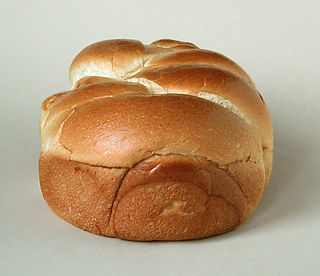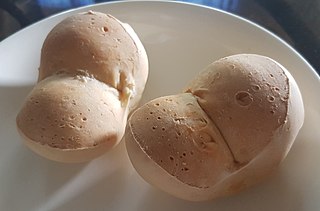
Brioche is a pastry of French origin whose high egg and butter content gives it a rich and tender crumb. The chef Joël Robuchon described it as "light and slightly puffy, more or less fine, according to the proportion of butter and eggs". It has a dark, golden, and flaky crust, frequently accentuated by an egg wash applied after proofing.

Dough is a thick, malleable, sometimes elastic paste made from grains or from leguminous or chestnut crops. Dough is typically made by mixing flour with a small amount of water or other liquid and sometimes includes yeast or other leavening agents, as well as ingredients such as fats or flavorings.

A fritter is a portion of meat, seafood, fruit, vegetables, or other ingredients which have been battered or breaded, or just a portion of dough without further ingredients, that is deep-fried. Fritters are prepared in both sweet and savory varieties.

The ensaïmada is a pastry product from Mallorca, Balearic Islands, Spain. It is a common cuisine eaten in southwestern Europe, Latin America and the Philippines.

Tiropita or tyropita is a Greek pastry made with layers of buttered phyllo and filled with a cheese-egg mixture. It is served either in an individual-size free-form wrapped shape, or as a larger pie that is portioned.

Ghanaian cuisine refers to the meals of the Ghanaian people. The main dishes of Ghana are centered around starchy staple foods, accompanied by either sauce or soup as well as a source of protein. The primary ingredients for the vast majority of soups and stews are tomatoes, hot peppers, and onions. As a result of these main ingredients, most Ghanaian soups and stews appear red or orange.

Tsoureki also known as šurēk, čöreg, čʿorek, katʿnahuncʿ, çörək (Azerbaijani), çyrek (Albanian), kozunak, cozonac (Romanian) or paskalya çöreği (Turkish) is a sweet holiday bread made with flour, milk, butter, eggs, and sugar and commonly seasoned with orange zest, mastic resin, or mahlab. Lampropsomo, a variation of tsoureki commonly called "Greek Easter bread," is made by Greek communities during Easter, not only in Greece, but also in other countries with Greek communities. It is also called Armenian Easter bread and gets eaten during Easter in Armenia and the Armenian diaspora.

Manakish, or in singular form man'ousheh, or other spellings, is a popular Levantine food consisting of dough topped with za'atar, cheese, or ground meat. It can be sliced or folded, and it can be served either for breakfast or lunch.

Coxinha is a popular food in Brazil consisting of chopped or shredded chicken meat, covered in dough, molded into a shape resembling a teardrop, battered and fried.

Baklava is a layered dessert made of filo pastry sheets, filled with chopped nuts, and sweetened with syrup or honey.

Placenta cake is a dish from ancient Greece and Rome consisting of many dough layers interspersed with a mixture of cheese and honey and flavored with bay leaves, baked and then covered in honey. The dessert is mentioned in classical texts such as the Greek poems of Archestratos and Antiphanes, as well as the De agri cultura of Cato the Elder. It is often seen as the predecessor of baklava and börek.
Boroña is a type of bread made with corn in northern Spain. This cornbread is a bread made with cornmeal. It is a traditional food from the regions of Galicia, Asturias, Cantabria, the Basque Country and northern Castilla-Leon, Spain. It has been widely used in rural areas until the mid twentieth century. It is usually cooked in an oven wrapped in cabbage leaves.

Quesada pasiega is a dessert typical of the region of Cantabria, Spain. It is one of the best-known dishes of Cantabrian cuisine. It has the consistency of a dense pudding, and is made from milk, sugar, butter, wheat flour, and egg, and flavored with lemon zest and cinnamon. The batter is typically mixed until smooth and then baked to perfection, resulting in a soft and creamy interior with a slightly firm outer layer. The dessert is known for its delicate sweetness, subtle hints of lemon or cinnamon. It can be served hot or cold. Quesada Pasiega is a beloved dessert in Cantabria, enjoyed on various occasions, from family gatherings to special celebrations. Its rich history and traditional preparation methods have made it a culinary gem, showcasing the region's culinary heritage and providing a delightful taste of Spanish gastronomy.
The Pasiega is a traditional Spanish breed of red dairy cattle from the autonomous community of Cantabria in northern Spain. It originated in the Valles Pasiegos in south-eastern Cantabria. The name derives from that of the Pas River, which flows through that region. Because of the colour of its coat it may also be known as the Roja Pasiega or Rojina.

Monay, also known as pan de monja, is a dense bread roll from the Philippines made with all-purpose flour, milk, and salt. It has a characteristic shape, with an indentation down the middle dividing the bread into two round halves. It is a common humble fare, usually eaten for merienda with cheese or dipped in hot drinks.













